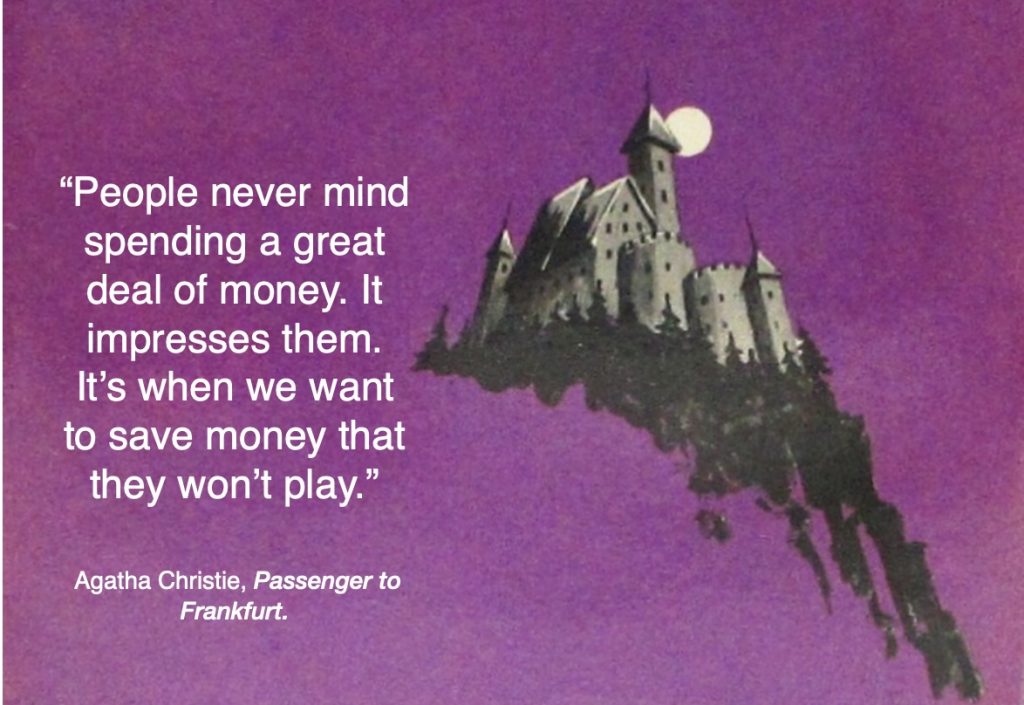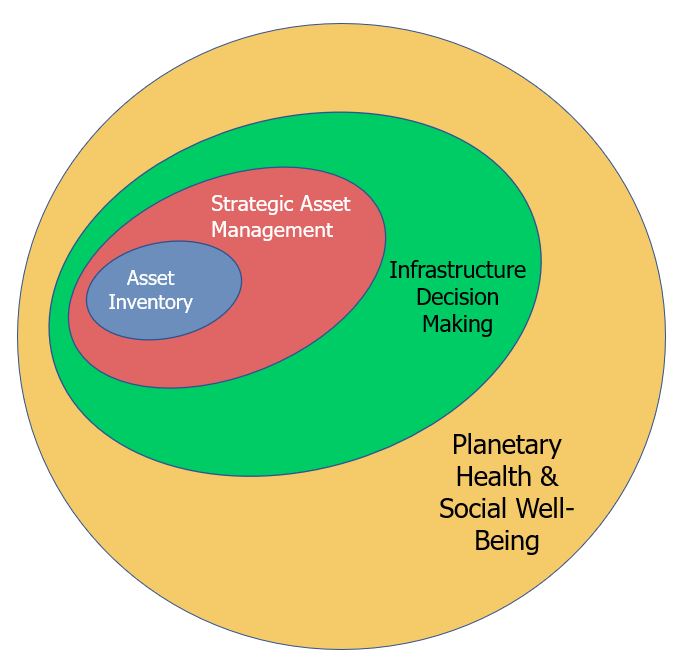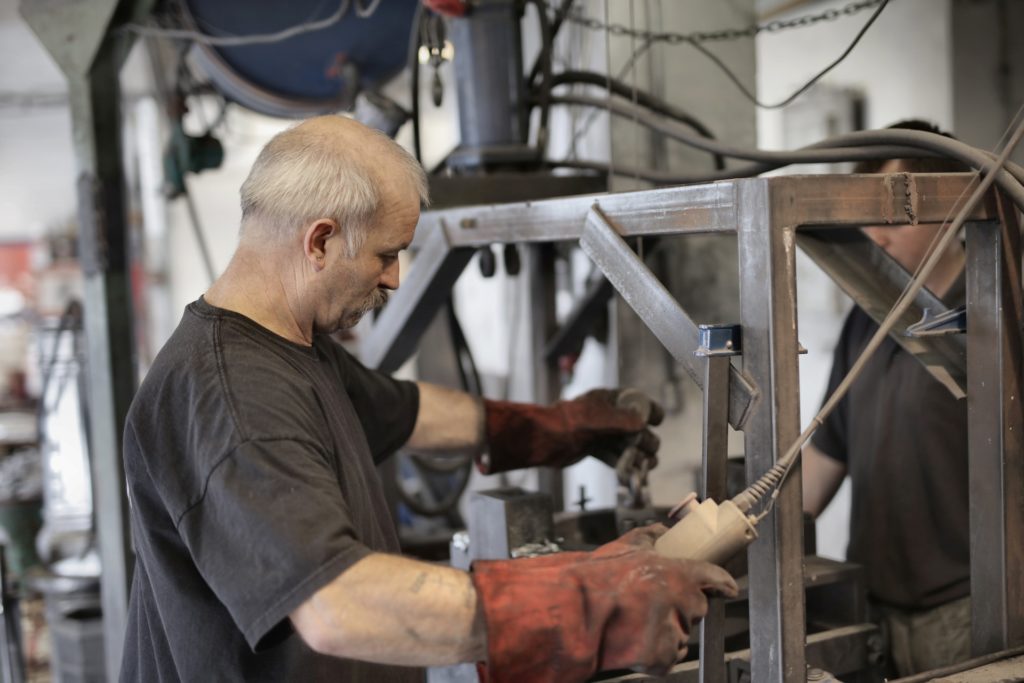
Is this the AM curse? Every election year we are presented with some impossibly expensive infrastructure project which generates great excitement – and acceptance. Invariably these projects are unaccompanied by any detailed analysis, for it is the idea itself that is so compelling, and so analysis just spoils it.
Is this the problem with AM? Are we trying to sell the detail, when all that is wanted – indeed all that can be absorbed by the general public – is the vision? This is not to say that detail is not needed but without an exciting vision, why will people listen?
I am looking for examples of good AM ‘visions’. Do you have, or know of, one?

In the early 1990s asset managers were so absorbed in the culture conflict between engineers and accountants that we gave short shrift to another conflict, that between scientists and management. If asset managers are now to effectively deal with the climate and environmental issues around infrastructure today this is an issue that we need to address. For this, I don’t think that we can do better than start with the excellent article by marine ecologist, Peter Cullen – also dating from the early 1990s.
In this article, Peter looks at the reasons for conflict between scientists and managers and suggests that there are three major reasons why it is difficult for scientists and managers to ‘get on’
- Friction between scientists and managers is often the result of misunderstandings about the culture within which each works.
- Many of the question that both are trying to solve are value questions not scientific ones or management ones.
- Managers often misunderstand science and expect it to deliver a truth that is nonarguable. They fail to understand the very process of science demands no such truths, so that assumptions, methods and conclusions can always be challenged.
He believes that the answer to this problem is to develop a ‘broking role’ – for people who understand both the scientific and management approach to provide a translation.
His argument about managers expecting science to provide a ‘truth that is non-arguable’ is an important one – and those who are currently disputing the ‘truth’ of global warming would be well advised to read and think about this short but powerful article.
However, I want to draw attention to what he has to say about cultures.
Understanding the cultures
“It is necessary to appreciate that the cultures pervading science are quite different from the cultures that pervade management. Without appreciating these cultural differences we will continue to be frustrated at the inadequate communication in both directions. Within professional ranks there are various mind sets inculcated during training and professional socialization. They can be parodied.
- Engineers don’t care why it works as long as they think it does.
- Scientists don’t care if it works or not as long as they understand why.
- Economists don’t care either way if the internal rate of return is OK.
- Managers don’t know unless someone bothers to tell them.
- Planners know how it should have turned out.”
The culture of Scientists
This includes sharing and openness through publication, conference presentations, travel;
honesty limitations of data/evidence;
emphasis on peer review;
organized scepticism;
peer rewards from quality of insights, experiments, analysis;
peer rewards for ability to select appropriate problems that have intellectual difficulty rather than immediate usefulness;
low status of data collection unless it is to test some hypothesis;
higher status for explanatory theories over empirical models;
some independence about what problems scientists will work upon.
The culture of management
- Managers have as their goal the delivery of benefits to some group. These might be abstract or generalized (policy) or specific (service delivery).
- Managers make decisions in order to reduce risks and they make pragmatic decisions to try to achieve this.
- Decisions are normally made with imperfect information and there is little pressure to review subsequently the assumptions in the light of effectiveness.
- There is often pride in the ability of managers to make decisions with little knowledge, and a culture which does not encourage quantitative evaluation and accountability.
- Technical skills are not directly valued in organizational hierarchies, and professionals have to become managers if they seek advancement to higher levels.
The Source of Conflict
Science is valued as a weapon in the ongoing conflict with other interest groups or agencies for power, influence and resources. Scientific outcomes, and the kudos of success, may be less important than staking out the turf to keep other players at bay. Public sector management appears to be undergoing a paradigm shift at the moment, and so there are two conflicting models.
(a) The bureaucratic model. The bureaucratic model has rules that are made to be followed. Following procedure is more important than particular outcomes. These systems are characterized by due process and formal procedures, rule books, secrecy and avoidance of performance review. The system rewards rule conformity, error avoidance and attention to detail.
(b) The managerial model. The managerial model is characterized by quantifiable outcomes that are more important than following set processes. Services are seen as products to be delivered to customers. There are devolved responsibilities within an externally set cost framework, and managers are assessed through cost-effectiveness reviews. Hence economic rationality replaces the legal and procedural framework of the bureaucratic model. The organization is seen as a tool in the hands of the executive manager or Minister, and is responsive to short-term political agendas. Rewards are for achieving output targets and nonachievement may be punished. Creates an environment where there must at least be a facade of progress, so if a problem is intractable there will be attempts to abandon it so at least the impression of progress can be created by moving on to new and relevant problems” .
What action do we need to take?
As Asset Managers we often get frustrated and annoyed when our ideas of what needs to be done runs counter to what others want to be done. Unfortunately a common response is to consider the others wrong, ignorant or even malicious. But let us first understand what they need to do to achieve their desires and see if we can’t work together.
Your comments?
If you have science colleagues, please share this with them for their ideas for a joint solution.
Footnote; Peter Cullen “The turbulent boundary between water science and water management”. Freshwater Biology, Vol 2. Issue 1, August 1990. He was described as ‘provocative, constructive, brave and always grounded in good science’. Peter was an Adelaide ‘Thinker in Residence’ in 2004. Sadly, he died in 2008. His ideas, however, live on.
In May 2018, Penny Burns and Jeff Roorda wrote here about three ‘revolutions’ in Asset Management – later renamed ‘waves’, because that captures better the idea that one wave doesn’t supersede another.
Since then, we have discussed with each other and many others how Wave 1, ‘Asset Inventory’, is more successful if you already have in mind the vision of Wave 2, ‘Strategic Asset Management’ and how you are going to use all of the information you collect.
We have looked at what Asset Management practitioners need to develop to move on from this, to be able to look beyond our own organisations, to a bigger role in supporting our communities. We called this Wave 3, supporting better ‘Infrastructure Decision Making’.
We have even begun to imagine Wave 4.

As Penny puts it: whereas Wave 1 looked at WHAT we had, and Wave 2 looked at HOW we needed to manage it, Wave 3 started to ask WHO we were serving by our efforts. This has brought us now to start thinking more deeply about this question and about the next move, looking at the critical question of WHY.
As Asset Management practitioners, we have to ensure we are in the right positions of influence to be able to challenge existing infrastructure assumptions, which is what I think Wave 3 is all about. To look ‘up and out’, as Lou Cripps of RTD puts it.
But we can already spot that there is no point in being able to ask hard questions, if we don’t have the right questions to ask….
What do we mean by ‘better’?

“The worst misunderstandings sometimes happen between different teams within the supposedly same ethnic group, particularly if they [come] from different locations or had different professional training (say, IT workers mingling with engineers)” – Gillian Tett
I have long been fascinated by differences in approach between engineers and Asset Management professionals – how AM is not just another variety of engineering. And, for that matter, why Operations managers don’t think like AMps, or how IT teams look at the world. For instance: what is it that motivates people in IT teams? (Not, I think, the pleasures of making users happy.)
In my own life, I seem to have sharply favoured working with maintenance, or ex-maintenance people, rather than Engineers with Capital E. Because they were very different experiences.
It is not that there have not been engineers who are massively important to me, such as my brother, or my parents’ best friend Ed – but then again, they never acted like typical engineers, and were not very polite about such ‘grey men’ (Ed’s phrase) themselves. That engineering does have its own cultural norms, some quite odd, has been a question for me for many decades.
So my eye was caught by the review of a book by Financial Times editor Gillian Tett, Anthro-Vision: How Anthropology Can Explain Business and Life. About trained anthropologists such as Tett who have found themselves working in businesses, such as Google or GM, or what they would advise governments on dealing with COVID-19.
She describes how anthropology is about both investigating what’s strange, other, exotic, and about the tools to see our own culture/s, to understand what is weird (or even WEIRD) about it. The book has plenty of interesting examples – about Kit Kats in Japan become an indispensable good luck charm for school exams, about dealing with Ebola or ‘CDOs’, as well as more effective advertising and work practices.
But it particularly made me think of how to understand the oddities of current engineering – why is so often tends towards the short term, to silos and uncoordinated stupidity, even resistance to data. Surely none of those attitudes are ‘logical’ – so what is really going on? I take it as given that, like IT, there is a coherent motivation, a vision of what it means to be a good engineer. So how come… that doesn’t play nice with Asset Management, so often?
And then again… what is the culture of Asset Management, developing before our eyes?
Because I also take it that if you don’t try to understand the water you swim in, you also don’t really understand what you are doing – how it might need to change or evolve – and why it gets up the nose of others who don’t share your basic values.
There is always culture, always weird to someone outside it, and managing infrastructure involves several different ones. So we must have anthropology in our Asset Management toolkits, too!

Next: Ethnographic approaches we might use in practice?

Any maintenance or asset manager knows that the longevity of assets is critically dependent on how well they are maintained. And you don’t have to be a maintenance manager to know that your car needs regular servicing. It is kind of obvious! Yet, when it comes to the important public infrastructure on which we all depend, maintenance is considered dispensable and is the first to be cut in times of financial stringency.
It is all to do with how we account for infrastructure assets. Below is the problem – and how we can overcome it using your asset management plan and condition based depreciation (CBD).
The Problem
It pays to know a little history. When government departments and agencies adopted accrual accounting practices and had to bring infrastructure assets to account for the first time, (In Australia, from 1989) naturally they turned to the private sector, where this had been the practice for many years. And this is where the first problem arose since private sector assets such as plant and machinery are depreciated over their predetermined lifespan until they reach zero or some predetermned salvage value and then they are completely replaced.
Infrastructure assets are different. This does not happen with infrastructure assets which can be kept in service for an indefinite time by piecemeal, if somewhat lumpy, component renewal. What is the age of an asset which may have some components 100 years old and others that were renewed yesterday? What is the life of an asset that can be kept in service as long as you want it to? These are unanswerable questions. They go to the heart of the difference between infrastructure and non-infrastructure assets and require a different accounting approach.
However when infrastructure assets were first brought to account, there was no alternative accounting approach for infrastructure assets, so rather than account for the entire infrastructure system, it was decided to assign each component a definite life and depreciate it as if it were an independent asset. It seemed a practical solution to a difficult problem. But in the process it completely ignored the key characteristic of infrastructure assets which is the interdependence of the components, where the life of a component, and thus the need to renew, is dependent on the other components with which it interacts. In other words, the life of components is indefinite, as is the life of the system as a whole. This does not mean infinite! It just means that you cannot define a life of a component until it reaches the stage of renewal. So depreciation in this case doesn’t work.
You will also notice something else about this approach. The economic life of any asset, as we stated at the beginning, depends on how well it is maintained, and yet maintenance does not feature in this accounting process. This is what makes it so easy for organisations to cut maintenance, since cutting maintenance does not affect the life of the asset, at least not in the accounting system – only in the real world!
The Solution
We need a better system, one that takes equal account of maintenance (minor and major) and renewal, i.e.everything that we need to spend to maintain the functionality of the asset. (In practice ‘maintenance’ and ‘renewal’ are really just different points on a continuum.)
Why do we depreciate assets at all? It is so that we can represent reduction in asset value in any particular period (asset value = its store of future services)
Is there a better way of doing this that recognises the distinct character of infrastructure assets? There is! What better way can there be of valuing the using up of asset services than the cost of making it good again? This is what is called Condition Based Depreciation (CBD). And it is available to any organisation that has a sound, and audited, AM plan as a costless spinoff. Put simply, the condition assessment of your assets that tells you what you need to spend over the planning period to maintain service function and that is in your AM Plan. It covers maintenance, minor and major and renewal and is the cost of making good the consumption of the asset over that period. You choose your planning period and it is updated on a rolling annual basis. The cost of ‘making good’ over the planning period is then expressed as an annuity to give you an annual cost and is the best estimate of real depreciation.
Second history lesson: When the UK water industry was being privatised in the early 1980s the argument was put forward that their assets should not be depreciated because the assets were continously maintained. This was rightly rejected by the accounting profession who said, in effect, ‘prove it’ and that is what a sound, audited AM plan does. Unfortunately some do not recognise the distinction between this and the AM plan backed CBD.
CBD was introduced in 1993 and has been well received by maintenance and asset managers and by practising accountants. It was adopted by the NSW Roads authority and by about a half of NZ’s councils for about ten years (until their accounting society called a halt). It is even provided as the ‘modified’ approach in GASB 34, the standard that introduced accrual accounting into the USA in 1999 but it was rejected by the Accounting Standards Board in 2004 and nothing much happened for the next 13-14 years!
Now it is back into contention because of problems with asset valuation giving depreciation figures that are artificially high and causing councils to be deemed non-viable. These councils are now scrambling to make cuts to their budget, eliminating services and sacking staff – and all at a time of Covid 19! So fictional figures are giving rise to real – and negative – physical effects. We can do better, much better!
Would CBD help bring your maintenance to the fore?
Extra references on CBD
Condition based depreciation for infrastructure assets, 1993
Depreciation of infrastructure assets
Condition based depreciation – the questions
- Extra information is provided here.
- Ask any questions you like and I will answer all of them.
To ask questions and to find out more about a national forum to develop support for adoption of CBD, use the comments section below. (There is global interest in this subject, so we might extend it to a global forum.)

In the last post I suggested that it might be time we changed our thinking on major issues like nuclear disarmament. But perhaps it is also time we changed our ideas on how we try to convince anyone to change anything!
I am indebted to Kerry McGovern for the following idea. She spoke of a friend who had argued that when introducing a new and controversial idea, 3% of the population are already of this opinion and do not need you to tell them, 7% are almost there and can be easily convinced, and about 30% recognise that they don’t know enough but are prepared to find out, the next 30% are too busy doing other things, and the last 30% are going to oppose you no matter what. Her advice is forget that bottom 60% and concentrate first on networking with the 3%, bringing in the 7% and then, as a group addressing the next 30%. I don’t know the source of the figures but the general idea is attractive. Moreover, working on these figures, once we have captured the 37%, assuming that the middle ‘busy’ 30% are neutral, we now have a majority on our side!
So often, we focus on the bottom 60% and see the issue as an ‘us and them’ antagonistic confrontation. But what if we were to look instead at the top 40% and see the issue as one of collaboration? Would not that be generally happier and more productive?

Last year I took part in a ‘Ban the Bomb’ march. Many organisations were involved, including WILPF (The Women’s International League for Peace and Freedom), and the photo above is thanks to the keen eye of WILPF’s International Treasurer, Kerry McGovern, who noticed it in an Instagram feed of hundreds of photos to celebrate the fact that the UN had reached the milestone of the 50th ratification of the UN Global Nuclear Weapons Ban Treaty.
Here’s the situation
With the Honduras, 50 countries have now ratified the UN Global Nuclear Weapons Ban Treaty and there was much celebration. There are 84 signatories, so 34 are still to ratify. None of the 84 have nuclear weapons. Meanwhile countries that do, like the USA, Russia, the UK, France and China, India, Pakistan and North Korea (and likely Israel) have not signed. Australia also has not signed. It does not have nuclear weapons but it does possess the uranium which makes them possible. So effectively those that have signed, even if they haven’t yet ratified, are those who have everything to gain and nothing to lose.
We are now just a few months away from the end of the ten year agreement between the USA and Russia to limit nuclear research and testing.
No wonder the world is getting nervous!
But is treating nuclear disarmament as a moral issue the most effective way forward?
It certainly is a moral issue, and ‘Ban the Bomb’ marches such as the one that I took part in last year, keep the issue in the public mind, but is this the most effective way to bring about change?
When we look at the issue clear eyed we can see that it is those who have nuclear weapons who are the most at risk, both physically and morally. They are the ones who have the difficult decisions to make, not the 84 signatories from the non-nuclear countries. And after the experience of Ukraine, a country that did have nuclear weapons but ceded them to Russia in the breakup of the USSR and then suffered the consequences, it is not surprising that those who currently possess nuclear arms are in no hurry to dispossess themselves.
So is it not time to invert our thinking?
Instead of collecting masses of signatories from non-nuclear nations, which only serves to make us feel we are doing something, when we really aren’t, perhaps we would be more effective if world organisations thought about how they could make things safer for nuclear weapons countries to dispossess, particularly for Russia and the USA.
I realise that thinking of nuclear armed nations as needing protection, rather than us being protected from them, is not the normal way of looking at the problem. But this ‘inverted’ thinking might serve us well in all of our encounters with others. It puts us all on the same side, rather than in ‘us v. them’ opposition. This idea can be used everywhere.
LATE BREAKING NEWS (FRIDAY 30 OCTOBER)
The Russian Mission in Vienna has just issued a 4 tweet communiqué which you can find at https://twitter.com/mission_rf/status/1321815042384449538?s=09 . Its complaint is valid and the results are just what you would expect when you set up an antagonistic, ‘Us v. Them’ framework. See what you think!
The 4 tweets read
- On January 22, 2021 Treaty on the Prohibition of Nuclear Weapons will enter into force. It was negotiated without Russia or other nuclear-weapon states. (We regret) this development for the following reasons:
- We don’t see any legal gaps in disarmament process for #TPNW to fill in. It was negotiated w/out taking into account fundamental principles of #NPT. Those principles should be applied consecutively and w/out distortion
- #Disarmament should be addressed only through consensus of all parties, including nuclear-weapon-states as per #NPT. #TPNW conceptual framework is unacceptable. It ignored strategic context & addressed #disarmament separately from existing international security environment.
- (We stand) for stands for nuclear weapons-free world & respects those sharing this view. But this process can’t be forced. We reaffirm our individual & collective #NPT commitments, but #TPNW is a mistake. It creates a rift btw states & harms #NPT. We won’t support, sign or ratify it.

Photo from commons.wikimedia.org, Escaping the jaws of a Banzai Pipeline wave
In the third part of our audio series on the Waves of Asset Management, we move on to talking about time.
Because effective Asset Management practitioners are time travellers, working with past, present and future: understanding where we are now, using historical experiences and data, in order to model the future.
What can Asset Management bring to better future planning? What must we bring? And what tools do we need to do this?
Part 3 of a discussion between Penny Burns, Ruth Wallsgrove, and Lou Cripps, in our new Thinking Infrastructure Aloud series. Please let us know what you think!

The wonderful ‘Big Picture’ animation from the Institute of Asset Management ends on a fascinating note:
Once we have optimised all our asset decisions to deliver our organisational goals – we can move on to asking about “the very reasons for the organisation’s existence”.
In part 2 of our audio series on the Waves of Asset Management, we explore alignment, a core principle of the Second Wave, or, Strategic Asset Management.
Hard as alignment is to achieve in practice – all those 1000s of asset decisions that have to add up in a co-ordinated, integrated way, now and into the future – it can raise an even bigger challenge for Asset Management practitioners. What are we aligning to?
What is the real purpose of my organisation?
And how can Asset Management help define it?
Part 2 of a discussion between Penny Burns, Ruth Wallsgrove, and Lou Cripps, in our new Thinking Infrastructure Aloud series – enjoy!
And let us know what you think!

Photograph by Andréa Farias Farias, Herdi no pedaço., CC BY-SA 2.0, https://commons.wikimedia.org/w/index.php?curid=83076806
In 2018 Penny Burns and Jeff Roorda suggested we describe our history in revolutions; a month ago, Penny proposed the history of Asset Management is more like Waves.
The First Wave of AM was to establish an asset inventory. We needed to know what we had to manage before we felt we could do anything else.
The Second Wave was to do something useful with this information: Strategic Asset Management, or better decisions to get a better answer in terms of cost, risk and performance. Of course, once we started actually using the data, we became much more aware of data quality and coverage. The need for good information didn’t go away. The best Asset Management practitioners are mostly still in Wave 2 – but already looking beyond it, for example in response to Covid-19.
The coming Third Wave is what Talking Infrastructure is all about. How to use what we have learned – all that data, sure, but more what’s involved in making better asset decisions – and look ‘up and out’ to the questions of what infrastructure our communities really need now, and into the uncertain future?
In March this year, after lockdown began, three of us – Penny Burns, Ruth Wallsgrove, and Lou Cripps of Denver Area transit agency RTD, across three continents – took the framework of the Three Waves and explored what this means to us in practice. Talking Infrastructure is happy here to deliver Part 1 of the recording, the first in an on-going series called Thinking Infrastructure Aloud that we intend not merely as audio downloads but public podcasts.
You get to be the pilot for this, and so: it is even more vital that you comment, and give us feedback on our move into sound!

Recent Comments